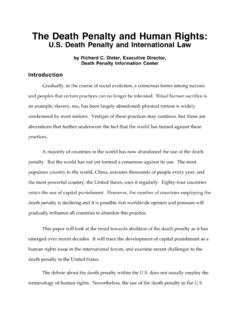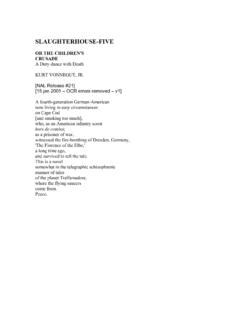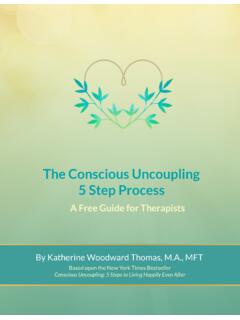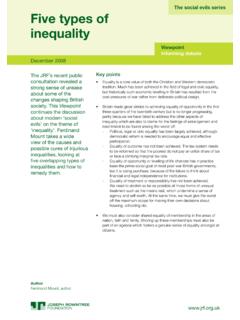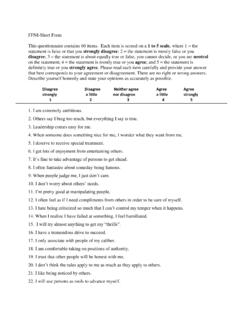Transcription of Summaries of 46 Cases in Which Mistaken or Perjured ...
1 ATTACHMENT ASummaries of 46 Cases in Which Mistaken or PerjuredEyewitness Testimony Put Innocent Persons on Death RowAdams, Randall Dale (convicted 1977, exonerated 1989) Mr. Adams was sentenced to deathfor the murder of a police officer in Dallas County, Texas. A purported eyewitness, who in factwas the actual killer, framed Mr. Adams and received immunity from prosecution in exchangefor his testimony. Mr. Adams was not involved in the crime. The facts came to light after film-maker Errol Morris took an interest in the case and produced a now- famous documentary TheThin Blue Line about the case. Mr. Adams and the victim were white. Time lapsed from arrestto exoneration: 147 , Gary (convicted 1976, exonerated 1979) Mr. Beeman was sentenced to death forthe murder of a man in Ashtabula County, Ohio. The conviction rested on the testimony of aprison escapee who claimed he saw Mr.
2 Beeman with the victim at about the time the coronerestimated the murder occurred and saw him again shortly thereafter with blood on his witness also claimed Mr. Beeman had admitted the crime. The Ohio Supreme Courtreversed the conviction because the trial judge had prevented Mr. Beeman from calling anexculpatory witness. At the retrial, Mr. Beeman was acquitted after five witnesses testified thatthe man who had been the prosecution s star witness at the first trial had confessed that hecommitted the crime and that Mr. Beeman was not involved. Both Mr. Beeman and the victimwere white. Time lapsed from arrest to exoneration: 11 , Jerry (convicted 1981, exonerated 1988) Mr. Bigelow was sentenced to death for amurder, robbery, and kidnaping in Merced County, California. He and a companion werehitchhiking when the victim gave them a ride. In exchange for immunity from the death penalty,the companion testified that Mr.
3 Bigelow shot the victim. After the companion accused of the murder, the police persuaded him to confess by promising him leniency apromise that would not be kept. Mr. Bigelow eventually was exonerated by several witnesseswho testified that the companion had admitted committing the crime while Mr. Bigelow wassleeping and without Mr. Bigelow s knowledge. Both Mr. Bigelow and the victim were lapsed from arrest to exoneration: 96 , Kirk (convicted 1984, exonerated 1993) Mr. Bloodsworth was twice sentencedto death for the rape and murder of a nine-year-old girl in Baltimore County, Maryland. Nophysical or circumstantial evidence linked Mr. Bloodsworth to the crime, but five witnessesplaced him either with the victim or near the crime scene at the time the crime was believed tohave occurred. DNA testing ultimately established Mr. Bloodsworth s innocence he was thefirst death row prisoner to be exonerated by DNA and he received a full pardon from thegovernor of Mr.
4 Bloodsworth and the victim were white. Time lapsed from arrest to exoneration: AiiBowen, Clifford Henry (convicted 1981, exonerated 1986) Mr. Bowen was sentenced todeath for the execution-style murders of three men beside a swimming pool at an Oklahoma Citymotel after two eyewitnesses testified they saw him standing beside concession machines nearthe pool shortly after the crime. After exhausting state remedies, Bowen filed a petition for afederal writ of habeas corpus, Which was granted on a showing that prosecutors had failed toprovide to the defense evidence that someone else committed the crime. Prosecutors vowed toretry Bowen, but finally dropped the charges, saying they could not win the case because a keywitness had died. Both Mr. Bowen and the victims were white. Time lapsed from arrest toexoneration: 70 , Willie (convicted 1983, exonerated 1988) Mr. Brown and co-defendant Larry Troywere sentenced to death for the murder of a fellow inmate in Florida s Union CorrectionalInstitution.
5 The conviction was based entirely upon the testimony of another prisoner whotestified that he saw them leave the victim s cell shortly before his body was discovered. AGerman anti-death-penalty activist took an interest in the case and, fitted with a hiddenmicrophone, obtained an admission from the witness that he had lied about the two men sinvolvement. The witness was then convicted of perjury and Messrs. Brown and Troy werereleased. Mr. Brown was black, the victim white. Time lapsed from arrest to exoneration: , Joseph Green (convicted 1974, exonerated 1987) Mr. Brown was sentenced to deathfor the murder and rape of a woman in Tampa, Florida. The state s case rested on the testimonyof a man who claimed he was riding in a car with Mr. Brown and another man when, for a reasonunclear to the witness, they stopped at a clothing shop. Mr. Brown and the other man, who wasnever found or identified, went inside while the witness stayed in the car.
6 A few minutes later,the witness claimed he heard a gunshot and rushed inside, where he saw the victim on the floor,apparently dead. On cross examination, the witness denied he had been promised anything inexchange for his testimony, but after Mr. Brown s conviction it came to light this was not on the apparent perjury, and the fact that the prosecution had failed to correct it, the of Appeals for the Eleventh Circuit ordered a new trial. After that, the witness who hadtied Mr. Brown to the crime recanted, saying he had lied because he was angry that Mr. Brownhad implicated him in the robbery case that had been dropped in exchange for the testimony thatsent Mr. Brown to death row. Mr. Brown was black, the victim white. Time lapsed from arrest toexoneration: 156 , Joseph (convicted 1989, exonerated 1994) Mr. Burrows was sentenced to death forthe murder and robbery of an 88-year-old farmer in Iroquois County, Illinois.
7 The only evidenceagainst Mr. Burrows was the testimony of two purported eyewitness-accomplices who testifiedagainst him in exchange for leniency for themselves sentences requiring each to serve no morethan 15 years in prison while Mr. Burrows was sentenced to death. Both witnesses ultimatelyrecanted their testimony, acknowledging that Mr. Burrows had nothing to do with the crime. Theexoneration was in substantial part the result of reporting by Peter Rooney, of the Champaign-ATTACHMENT AiiiUrbana News-Gazette. Both Mr. Burrows and the victim were white. Time lapsed from arrest toexoneration: 70 , Earl Patrick (convicted 1975, exonerated 1978) Mr. Charles was sentenced todeath for the murder of a furniture store owner and his son during a robbery in Chatham County,Georgia. The key evidence against Mr. Charles was eyewitness testimony from a survivingwitness who had failed initially to identify him in a photo spread.
8 The prosecution also presentedan informant who claimed to have heard Mr. Charles confess to the killing. While a motion for anew trial was pending, a reinvestigation by the prosecution discovered that a detective hadcoached both the eyewitness and the informant; the latter eventually admitted that he made upthe story at the detective s behest. The prosecution joined in the motion for a new trial and, whenit was granted, dropped the charges. Mr. Charles received a $75,000 civil rights settlement forthe detective s misconduct. Mr. Charles was black, the victims white. Time lapsed from arrest toexoneration: 43 , Eric (convicted 1987, exonerated 2000) Mr. Clemmons, a Missouri prisoninmate, was sentenced to death for the fatal stabbing of another prisoner. The case rested solelyon the testimony of a corrections officer who saw the murder. He testified that, during the actualstabbing, he was too far away to see who the killer was, but gave chase and saw that the man wasMr.
9 Clemmons. At the trial in Greene County, Missouri, the defense called several prisoners whoclaimed the murder had been committed not by Mr. Clemmons but by a prisoner who died threemonths after the crime a contention the prosecution portrayed as self-serving and unworthy ofbelief. After his conviction, Mr. Clemmons, working on his own appeal, discovered an internalprison memorandum, prepared by a prison supervisor immediately after the crime, stating thatthe murder had been committed by the prisoner whom the defense witnesses had identified at thetrial. Based on that and other new evidence, the Court of Appeals for the Eighth Circuitgranted Mr. Clemmons a new trial, at Which he was acquitted. Mr. Clemmons was black, thevictim white. Time lapsed from arrest to exoneration: 174 , Perry (convicted 1979, exonerated 1987) After two trials ended in hung juries, and a co-defendant, Darby Tillis (aka Williams), were convicted and sentenced to death attheir third trial for the slaying of two men in an all-night diner in Chicago.
10 The principalevidence against them was the testimony of a woman who portrayed herself as an unwittingaccomplice to the crime. She was not an eyewitness in fact, she claimed she learned of themurders later but her testimony was corroborated at the third trial by a bartender who workedacross the street from the diner and positively identified the defendants as the killers, although hehad failed to make positive identifications at the first two trials. The Illinois Supreme Courtordered a new trial because of judicial error at the first trial. A monthly publication, ChicagoLawyer, published a lengthy article about the case, and a prosecutor in a neighboring county readit. That prosecutor testified at the defendants retrial that the principal witness at the earlier trialshad admitted committing the double murder with her boyfriend. Messrs. Cobb and Tillis wereacquitted and subsequently received full pardons from the governor of Illinois.

